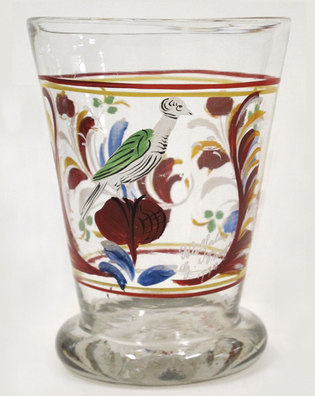 loading
loading
Arts & CultureNot what it seemsObject lesson: using science and connoisseurship to investigate a possible fake antique. John Stuart Gordon is the Benjamin Attmore Hewitt Associate Curator of American Decorative Arts at the Yale University Art Gallery.  Yale University Art Gallery, Mabel Brady Garvan CollectionThis gaily decorated drinking vessel was supposedly crafted for the owner of an important glassmaking business in the American colonies. View full imageAfter 80 years in the Yale Art Gallery’s collection, what was once a treasured antique is now more interesting for what it isn’t than for what it is. In 1930, Francis P. Garvan ’97 donated his renowned collection of American decorative arts to Yale in honor of his wife, Mabel Brady Garvan. The gift included a rummer, a kind of drinking vessel popular in the late eighteenth century that had a large bowl and a thick square or circular foot. It was made of clear glass and decorated with brightly colored enamels depicting a bird perched amid leaves and flowers. Below the bird, in white enamel, was the inscription “William H. Stiegel 1770.” The rummer was purported to have been made for Henry William Stiegel at the glasshouse he owned and operated in Manheim, Pennsylvania—important to modern collectors because it was one of the first commercially viable glasshouses in the American colonies and the first to manufacture lead glass. The piece was considered one of the highlights of Garvan’s collection, and it was pictured in magazines such as The Antiquarian. But it quickly became the subject of speculation. In 1937, John Marshall Phillips, curator of the Garvan Collections, lamented to a colleague that another collector “has cast some aspersions” on the piece. A few years later, the influential glass scholars George and Helen McKearin declared that the inscription was “doubtful,” as they believed Stiegel had not yet started producing enameled glass by 1770. Scholarship undertaken in the 1980s by Arlene Palmer disproved the McKearins’ dating but questioned how the rummer could have been made with lead glass at a time when Stiegel supposedly did not use lead glass. Other scholars have suggested the rummer was in fact Bohemian and exported to America. When I first encountered the rummer, I found its momentary fame in the late 1920s and rapid descent into obscurity intriguing. As I studied it, applying the close reading of objects that is integral to connoisseurship—that is, art historical expertise—still more questions occurred to me. If the rummer was Bohemian, why was the name “William” spelled in the English manner? If it was made for “Henry William” Stiegel, why was it inscribed “William H.”? Alternatively, if the inscription had been added after the fact, as the McKearins had suggested, wouldn’t reheating the glass to fuse the new enamel have damaged the old enamel decoration? I contacted Anikó Bezur, director of scientific research at Yale’s new Center for Conservation and Preservation. Bezur used X-ray fluorescence spectroscopy to determine if the chemical composition of the enamel used for the inscription and the decoration matched. The results showed that all white elements were chemically similar enamels, and thus the decoration and inscription were likely the same age. But tests on the other colors proved more revealing. The green enamel consisted of a mix of chromium-based green and cobalt-based blue. Chromium, however, was discovered in 1797—nearly 30 years after the rummer was supposed to have been made. Suddenly we knew that the decoration, if not the whole object, was most likely a nineteenth-century confection. Generations of scholars had suspected that something was amiss with Garvan’s rummer, but none could agree on what. Scientific analysis confirmed their intuition and provided valuable information. Although the rummer is no longer a document of glassmaking in early America, it has become a potent example of how connoisseurship can suggest what questions to ask and science can provide answers that deepen our knowledge about works of art.
The comment period has expired.
|
|